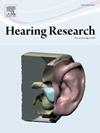Optical coherence tomography imaging demonstrates endolymphatic hydrops in the lateral and posterior semicircular canals in noise-exposed mice
IF 2.5
2区 医学
Q1 AUDIOLOGY & SPEECH-LANGUAGE PATHOLOGY
引用次数: 0
Abstract
Optical Coherence Tomography (OCT) has been used to characterize cochlear endolymphatic hydrops (ELH) with distention of Reissner’s membrane in mice after noise exposure. Noise exposure has been correlated with vestibular dysfunction, so we hypothesized that noise exposure can lead to ELH in the vestibular system. Little work has been performed using OCT to image the membranous labyrinth in the lateral and posterior semicircular canals (SCCs). We show that OCT with 12.5 µm axial resolution and 13.2 µm lateral resolution can image the SCCs and delineate the membranous labyrinth in anesthetized mice. A high-resolution OCT system with 2.45 µm axial and 3.95 µm lateral resolution provides improved distinction between the endolymphatic and perilymphatic fluid spaces that enables quantification of the endolymph to perilymph (E/P) area ratio in the SCCs. The LSCC E/P ratio in noise exposed mice (5.16 ± 0.67, mean ± standard deviation, n = 12) is significantly increased (p = 0.0014, unpaired Student’s t-test) compared to control mice (4.26 ± 0.41, n = 10). Similarly, the PSCC E/P ratio in noise exposed mice (4.92 ± 0.52, n = 12) is significantly increased (p = 3.65e-6, unpaired Student’s t-test) compared to control mice (4.00 ± 0.37, n = 11). Furthermore, the PSCC and LSCC E/P ratios correlate significantly (R2 = 0.284, p = 0.0063, linear regression). These data demonstrate that noise exposure leads to increased E/P ratio, a measurement of ELH, in both the LSCC and PSCC in mice, and this corresponds to ELH present in the cochlea after noise exposure. Therefore, noise exposure leads to ELH in both the cochlea and the vestibular system, suggesting a pathway for noise exposure to cause vestibular dysfunction.
光学相干断层成像显示噪声暴露小鼠的外侧和后半规管内淋巴水肿
采用光学相干断层扫描(OCT)对噪声暴露后小鼠耳蜗内淋巴积液(ELH)伴雷氏膜扩张进行了表征。噪声暴露与前庭功能障碍相关,因此我们假设噪声暴露可导致前庭系统ELH。使用OCT成像外侧和后半规管(SCCs)的膜性迷路的工作很少。我们发现,轴向分辨率12.5µm和横向分辨率13.2µm的OCT可以在麻醉小鼠中成像SCCs并描绘膜迷路。高分辨率OCT系统轴向分辨率为2.45µm,横向分辨率为3.95µm,可以更好地区分淋巴内和淋巴周围的液体空间,从而可以量化SCCs的内淋巴与淋巴周围(E/P)面积比。噪声暴露小鼠LSCC E/P比(5.16±0.67,平均值±标准差,n = 12)显著高于对照组(4.26±0.41,n = 10) (P = 0.0014,未配对Student 's t检验)。噪声暴露小鼠的PSCC E/P比(4.92±0.52,n = 12)显著高于对照组(4.00±0.37,n = 11) (P = 3.65e-6,未配对学生t检验)。此外,PSCC和LSCC的E/P比显著相关(R2 = 0.284, P = 0.0063,线性回归)。这些数据表明,噪声暴露导致小鼠LSCC和PSCC的E/P比(ELH的测量指标)增加,这与噪声暴露后耳蜗中的ELH相对应。因此,噪声暴露导致耳蜗和前庭系统的ELH,提示噪声暴露导致前庭功能障碍的途径。
本文章由计算机程序翻译,如有差异,请以英文原文为准。
求助全文
约1分钟内获得全文
求助全文
来源期刊

Hearing Research
医学-耳鼻喉科学
CiteScore
5.30
自引率
14.30%
发文量
163
审稿时长
75 days
期刊介绍:
The aim of the journal is to provide a forum for papers concerned with basic peripheral and central auditory mechanisms. Emphasis is on experimental and clinical studies, but theoretical and methodological papers will also be considered. The journal publishes original research papers, review and mini- review articles, rapid communications, method/protocol and perspective articles.
Papers submitted should deal with auditory anatomy, physiology, psychophysics, imaging, modeling and behavioural studies in animals and humans, as well as hearing aids and cochlear implants. Papers dealing with the vestibular system are also considered for publication. Papers on comparative aspects of hearing and on effects of drugs and environmental contaminants on hearing function will also be considered. Clinical papers will be accepted when they contribute to the understanding of normal and pathological hearing functions.
 求助内容:
求助内容: 应助结果提醒方式:
应助结果提醒方式:


